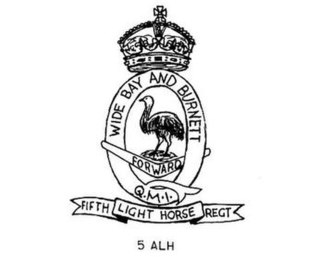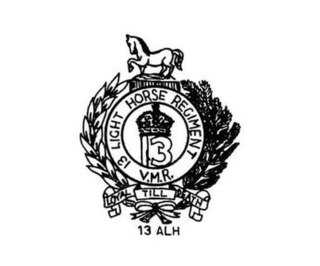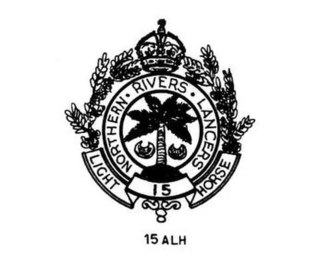
Australian Light Horse were mounted troops with characteristics of both cavalry and mounted infantry, who served in the Second Boer War and World War I. During the inter-war years, a number of regiments were raised as part of Australia's part-time military force. These units were gradually mechanised either before or during World War II, although only a small number undertook operational service during the war. A number of Australian light horse units are still in existence today.
The Australian Mounted Division originally formed as the Imperial Mounted Division in January 1917, was a mounted infantry, light horse and yeomanry division. The division was formed in Egypt, and along with the Anzac Mounted Division formed part of Desert Column, Egyptian Expeditionary Force in World War I. The division was originally made up of the Australian 3rd Light Horse Brigade, the reconstituted 4th Light Horse Brigade, and two British yeomanry brigades; the 5th Mounted Brigade and 6th Mounted Brigade.
The 5th Battalion was an infantry battalion of the Australian Army. Raised in Victoria as part of the First Australian Imperial Force for service during World War I, the battalion formed part of the 2nd Brigade, attached to the 1st Division. It participated in the landing at Anzac Cove on 25 April 1915, coming ashore in the second wave, before taking part in the fighting at Krithia and then at Lone Pine. In December 1915, the battalion was withdrawn from the peninsula and returned to Egypt where it was involved in defending the Suez Canal until being transferred to the Western Front in France in early 1916. After that, over the course of the next two and a half years the 5th Battalion was rotated in and out of the front line and took part in a number of significant battles including at Pozieres, Ypres, Amiens and the Hindenburg Line. Following the end of the war, the battalion was disbanded and its personnel returned to Australia. The battalion was re-raised during the inter-war years as a part-time unit and was later mobilised during World War II, but did not serve overseas. During the post war period, the battalion has existed at various times before being subsumed into the 5th/6th Battalion, Royal Victoria Regiment.

The 1st Royal New South Wales Lancers was an Australian Army light cavalry (reconnaissance) regiment. Its complicated lineage includes the New South Wales Lancers which was first formed as a colonial unit in 1885 as the New South Wales Cavalry, and subsequently saw action in the Second Boer War, and later during First World War at Gallipoli and Palestine as the 1st Light Horse Regiment. The unit subsequently served during the Second World War as the 1st Armoured Regiment equipped with Matilda tanks, fighting the Japanese in New Guinea and Borneo.

The 12th/16th Hunter River Lancers is an Australian Army Reserve cavalry regiment. It was formed on 1 May 1948, although it draws its lineage from units that were originally formed in the 1880s. It is currently a Light Cavalry unit equipped with Bushmaster Protected Mobility Vehicles. The regiment forms part of the 11th Brigade, attached to the 2nd Division and draws its members from regional centres in northern New South Wales, hence the reference to the Hunter River. Since 2000 the regiment has provided individuals as reinforcements to round-out Regular Army units deploying overseas on peacekeeping operations and in the conflicts in Iraq and Afghanistan.

The 1st Light Horse Brigade was a mounted infantry brigade of the Australian Imperial Force (AIF), which served in the Middle Eastern theatre of World War I. The brigade was initially formed as a part-time militia formation in the early 1900s in New South Wales and then later in Queensland. In 1914, the brigade was re-constituted as part of the AIF and was sent to Egypt. Forming part of the New Zealand and Australian Division, during the Gallipoli Campaign it served in a dismounted role between May and December 1915. After being withdrawn to Egypt it served in the Anzac Mounted Division from March 1916 as part of the Egyptian Expeditionary Force, taking part in the Sinai and Palestine Campaign until the end of the war. It was disbanded in 1919. After the war, the AIF light horse regiments were demobilised and disbanded; however, the brigade briefly existed as a part-time militia formation in Queensland until 1921 when its regiments were reorganised into cavalry brigades.

The 2nd Light Horse Brigade was a mounted infantry brigade of the Australian Imperial Force (AIF) which served in the Middle Eastern theatre of World War I. The brigade was initially formed as a part-time militia formation in the early 1900s in New South Wales. In 1914, the brigade was re-constituted as part of the AIF. The brigade first saw action while serving in the Australian and New Zealand Army Corps (ANZAC) during the Gallipoli campaign. After being withdrawn to Egypt in February 1916 they served in the ANZAC Mounted Division from March 1916 as part of the Egyptian Expeditionary Force during the Sinai and Palestine Campaign until the end of the war. After the war, the AIF light horse regiments were demobilised and disbanded; however, the brigade briefly existed as a part-time militia formation in New South Wales until 1921 when its regiments were reorganised into cavalry brigades.

The 3rd Light Horse Brigade was a mounted infantry brigade of the Australian Imperial Force (AIF), which served in the Middle Eastern theatre of World War I. The brigade was initially formed as a part-time militia formation in the early 1900s in Victoria. In 1914, the brigade was re-constituted as part of the AIF. The brigade first saw action while serving with the Australian and New Zealand Army Corps during the Gallipoli campaign where they were noted for their attack during the Battle of the Nek. After being withdrawn to Egypt in February 1916 they were involved in the Sinai and Palestine Campaign until the end of the war. They were attached to a number of different formations being part of the Anzac Mounted Division in March 1916 and the Australian Mounted Division in June 1917, who they remained with until the end of the war. After the war, the AIF light horse regiments were demobilised and disbanded; however, the brigade briefly existed as a part-time militia formation in New South Wales until 1921 when its regiments were reorganised into cavalry brigades.

The 12th Light Horse Regiment was a mounted unit of the Australian Army. It was raised in New South Wales in 1915 as part of the Australian Imperial Force (AIF) for service during the First World War. After fighting at Gallipoli as reinforcements, the regiment served in the Sinai and Palestine campaign against the Ottoman Empire, seeing action in several notable battles including Beersheba, the capture of Jerusalem, Megiddo and the capture of Damascus. In the aftermath of the war, the regiment was used to suppress the 1919 Egyptian Uprising, before being disbanded in late 1919.

The 2nd Light Horse Regiment was a mounted infantry regiment of the Australian Army during the First World War. The regiment was raised in September 1914, and by December as part of the 1st Light Horse Brigade had moved overseas. During the war the regiment only fought against the forces of the Ottoman Empire, in Egypt, at Gallipoli, on the Sinai Peninsula, and in Palestine and Jordan. After the armistice the regiment eventually returned to Australia in March 1919. For its role in the war the regiment was awarded nineteen battle honours.

The 3rd Light Horse Regiment was a mounted infantry regiment of the Australian Army during the First World War. The regiment was raised in September 1914, and by December as part of the 1st Light Horse Brigade had moved overseas. The regiment only fought against the forces of the Ottoman Empire, in Egypt, at Gallipoli, on the Sinai Peninsula, and in Palestine and Jordan. After the armistice the regiment eventually returned to Australia in March 1919. For its role in the war the regiment was awarded nineteen battle honours.

The 4th Light Horse Regiment was a mounted infantry regiment of the Australian Army during the First World War. The regiment was raised in August 1914, as the divisional cavalry regiment for the 1st Division. The regiment fought against the forces of the German Empire and the Ottoman Empire, in Egypt, at Gallipoli, on the Western front, on the Sinai Peninsula, and in Palestine and Jordan. After the armistice the regiment eventually returned to Australia in March 1919. For its role in the war the regiment was awarded twenty-one battle honours.

The 5th Light Horse Regiment was a mounted infantry regiment of the Australian Army during the First World War. The regiment was raised in August 1914, and assigned to the 2nd Light Horse Brigade. The regiment fought against the forces of the Ottoman Empire, in Egypt, at Gallipoli, on the Sinai Peninsula, and in Palestine and Jordan. After the armistice the regiment eventually returned to Australia in March 1919. For its role in the war the regiment was awarded sixteen battle honours.

The 6th Light Horse Regiment was a mounted infantry regiment of the Australian Army during the First World War. The regiment was raised in September 1914, and assigned to the 2nd Light Horse Brigade. The regiment fought against the forces of the German Empire and the Ottoman Empire, in Egypt, at Gallipoli, on the Sinai Peninsula, and in Palestine and Jordan. After the armistice the regiment eventually returned to Australia in March 1919. For its role in the war the regiment was awarded sixteen battle honours. During the inter-war years, the regiment was re-raised as a part-time unit based in New South Wales, adopting the designation of the "New South Wales Mounted Rifles". It was later converted to a motor regiment during the early years of the Second World War before being redesignated as an armoured car regiment. Nevertheless, it was disbanded in early 1943 without having been deployed overseas. During the post war years, the regiment was re-raised as part of the Citizens Military Force, and in 1956 was converted into an infantry unit, and in 1960 was subsumed into the Royal New South Wales Regiment.

The 8th Light Horse Regiment was a mounted rifles regiment of the Australian Army during the First World War. The regiment was raised in September 1914, and assigned to the 3rd Light Horse Brigade. The regiment fought against the forces of the Ottoman Empire, in Egypt, at Gallipoli, on the Sinai Peninsula, and in Palestine and Jordan. After the armistice the regiment eventually returned to Australia in March 1919. For its role in the war the regiment was awarded fifteen battle honours. During the inter-war years, the 8th Light Horse was re-raised as a part-time unit based in the Indi region of northern Victoria. It was later converted to a divisional cavalry regiment during the Second World War but was disbanded in 1944 without having been deployed overseas.

The 9th Light Horse Regiment was a mounted rifles regiment of the Australian Army during the First World War. The regiment was raised in October 1914, and assigned to the 3rd Light Horse Brigade. The regiment fought against the forces of the Ottoman Empire, in Egypt, at Gallipoli, on the Sinai Peninsula, and in Palestine and Jordan. After the armistice the regiment eventually returned to Australia in March 1919. For its role in the war the regiment was awarded fifteen battle honours.

The 13th Light Horse Regiment was a mounted infantry regiment of the Australian Army during the First World War. The regiment was raised in March 1915, and eventually assigned as the mounted regiment for the Australian Corps. During the war the regiment fought against the forces of the Ottoman Empire, at Gallipoli, and against the German Empire on the Western Front. For its role in the war the regiment was awarded twelve battle honours. In 1921, it was later re-raised as a part-time unit of the Citizens Forces, and was briefly amalgamated with the 19th Light Horse. During the Second World War, the regiment was converted into an armoured regiment, designated the "13th Armoured Regiment", although it was disbanded in late 1943 without seeing action.

The 11th Light Horse Regiment was a mounted infantry regiment of the Australian Army during the First World War. The regiment was raised in August 1914, and assigned to the 4th Light Horse Brigade. The regiment fought against the forces of the Ottoman Empire, in Egypt, at Gallipoli, on the Sinai Peninsula, and in Palestine and Jordan. After the armistice the regiment eventually returned to Australia in March 1919. For its role in the war the regiment was awarded fourteen battle honours. During the inter-war years, the regiment was re-raised as a part-time unit based in the Darling Downs region of Queensland. It was later converted to a motor regiment during the Second World War but was disbanded in 1943 without having been deployed overseas.

The 15th Light Horse Regiment was a mounted infantry regiment of the Australian Army during the First World War. The regiment was raised in Palestine in 1918, from soldiers that had been serving with the Imperial Camel Corps Brigade, and assigned to the 5th Light Horse Brigade. During the war the regiment fought against the forces of the Ottoman Empire, in the Sinai and Palestine Campaign and was awarded fourteen battle honours. During the inter-war years, the regiment was re-raised as a part-time unit based in the Northern Rivers region of New South Wales. It was later converted to a motor regiment during the Second World War but was disbanded in 1944 without having been deployed overseas. In the post war period, the regiment was briefly re-formed, before being amalgamated into the 1st/15th Royal New South Wales Lancers in 1956.

The 20th Pioneer Battalion was an Australian Army pioneer unit that served in New Guinea during World War II. A Militia unit, the battalion was originally formed as a light horse regiment in 1918. Through the 20th Light Horse Regiment, the unit drew lineage back to early Victorian colonial forces, raised in 1885. During the early part of World War II, the unit was converted from a light horse regiment to a motorised unit – the 20th Motor Regiment – and undertook defensive duties in Victoria and then Queensland. In 1944, it deployed in a dismounted role to Merauke in Dutch New Guinea, to defend the Allied airfield that had been constructed there. The unit was later converted into a pioneer battalion in early 1945, deploying to New Guinea in the final stages of the war. It was disbanded in November 1945.



























